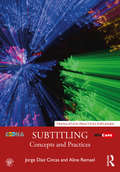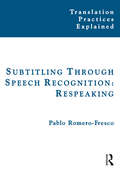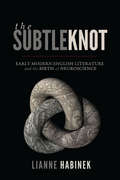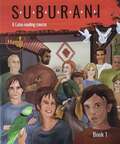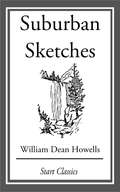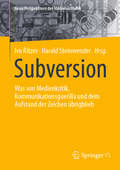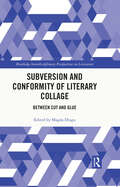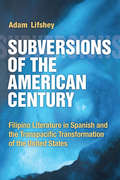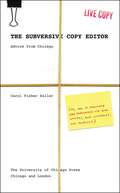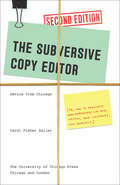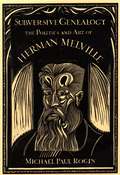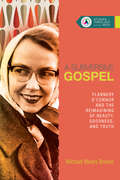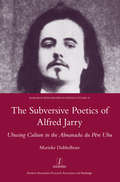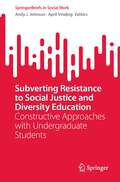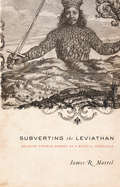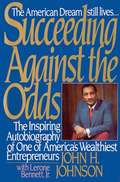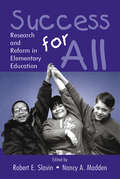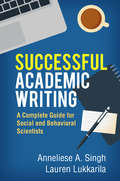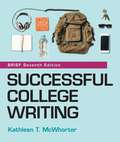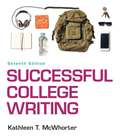- Table View
- List View
Subtitling: Concepts and Practices (Translation Practices Explained)
by Aline Remael Jorge Díaz CintasSubtitling: Concepts and Practices provides students, researchers and practitioners with a research-based introduction to the theory and practice of subtitling. The book, inspired by the highly successful Audiovisual Translation: Subtitling by the same authors, is a new publication reflecting the developments in practice and research that mark subtitling today, while considering the way ahead. It supplies the core concepts that will allow its users to acquaint themselves with the technical, linguistic and cultural features of this specific yet extremely diverse form of audiovisual translation and the many contexts in which it is deployed today. The book offers concrete subtitling strategies and contains a wealth of examples in numerous languages for dealing with specific translation problems. State-of-the art translation technologies and their impact on the profession are explored along with a discussion of the ways in which they cater for the socio-political, multicultural and multilingual challenges that audiovisual productions and their translations must meet today. A truly multimedia package, Subtitling: Concepts and Practices comes with a companion website which includes a wide range of exercises with answer keys, video clips, dialogue lists, a glossary of concepts and terminology used in the industry and much more. It also provides access to a professional desktop subtitle editor, Wincaps Q4, and a leading cloud-based subtitling platform, OOONA.
Subtitling Through Speech Recognition: Respeaking
by Pablo Romero-FrescoBased on sound research and first-hand experience in the field, Subtitling through Speech Recognition: Respeaking is the first book to present a comprehensive overview of the production of subtitles through speech recognition in Europe. Topics covered include the origins of subtitling for the deaf and hard of hearing, the different methods used to provide live subtitles and the training and professional practice of respeaking around the world. The core of the book is devoted to elaborating an in-depth respeaking course, including the skills required before, during and after the respeaking process. The volume also offers detailed analysis of the reception of respeaking, featuring information about viewers' preferences, comprehension and perception of respoken subtitles obtained with eye-tracking technology.An accompanying DVD features a wealth of video clips and documents designed to illustrate the material in the book and to serve as a basis for the exercises included at the end of each chapter. The working language of the book is English, but the DVD also contains sample material in Dutch, French, Galician, German, Italian and Spanish.Subtitling through Speech Recognition: Respeaking is designed for use as a course book for classroom practice or as a handbook for self-learning. It will be of interest to undergraduate and postgraduate students as well as freelance and in-house language professionals. It will also find a reading public among broadcasters, cinema, theatre and museum managers, as well as the deaf and members of deaf associations, who may use the volume to support future campaigns and enhance the quality of the speech-to-text accessibility they provide to their members.
The Subtle Knot: Early Modern English Literature and the Birth of Neuroscience
by Lianne HabinekIn the early modern period, poetic form underpinned and influenced scientific progress. The language and imagery of seventeenth-century writers and natural philosophers reveal how the age-old struggle between body and soul led to the brain’s emergence as a curiosity in its own right. Investigating the intersection of the humanities and sciences in the works of authors ranging from William Shakespeare and John Donne to William Harvey, Margaret Cavendish, and Johann Remmelin, Lianne Habinek tells how early modernity came to view the brain not simply as grey matter but as a wealth of other wondrous possibilities – a book in which to read the soul’s writing, a black box to be violently unlocked, a womb to nourish intellectual conception, a creative engine, a subtle knot that traps the soul and thereby makes us human. For seventeenth-century thinkers, she argues, these comparisons were not simply casual metaphors but integral to early ideas about brain function. Demonstrating how the disparate fields of neuroscientific history and literary studies converged, The Subtle Knot tells the story of how the mind came to be identified with the brain.
The Subtle Subtext: Hidden Meanings in Literature and Life
by Laurent PernotSubtexts are all around us. In conversation, business transactions, politics, literature, philosophy, and even love, the art of expressing more than what is explicitly said allows us to live and move in the world. But rarely do we reflect on this subterranean dimension of communication.In this book, renowned classicist and scholar of rhetoric Laurent Pernot explores the fascinating world of subtext. Of the two meanings present in any instance of double meaning, Pernot focuses on the meaning that is unstated—the meaning that counts. He analyzes subtext in all its multifarious forms, including allusion, allegory, insinuation, figured speech, irony, innuendo, esoteric teaching, reading between the lines, ambiguity, and beyond. Drawing on examples from figures as varied as Homer, Shakespeare, Molière, Proust, Foucault, and others, as well as from popular culture, Pernot shows how subtext can be identified and deciphered as well as how prevalent and essential it is in human life.With erudition and wit, Pernot explains and clarifies a device of language that we use and understand every day without even realizing it. The Subtle Subtext is a book for anyone who is interested in language, literature, hidden meanings, and the finer points of social relations.
The Subtle Subtext: Hidden Meanings in Literature and Life
by Laurent PernotSubtexts are all around us. In conversation, business transactions, politics, literature, philosophy, and even love, the art of expressing more than what is explicitly said allows us to live and move in the world. But rarely do we reflect on this subterranean dimension of communication.In this book, renowned classicist and scholar of rhetoric Laurent Pernot explores the fascinating world of subtext. Of the two meanings present in any instance of double meaning, Pernot focuses on the meaning that is unstated—the meaning that counts. He analyzes subtext in all its multifarious forms, including allusion, allegory, insinuation, figured speech, irony, innuendo, esoteric teaching, reading between the lines, ambiguity, and beyond. Drawing on examples from figures as varied as Homer, Shakespeare, Molière, Proust, Foucault, and others, as well as from popular culture, Pernot shows how subtext can be identified and deciphered as well as how prevalent and essential it is in human life.With erudition and wit, Pernot explains and clarifies a device of language that we use and understand every day without even realizing it. The Subtle Subtext is a book for anyone who is interested in language, literature, hidden meanings, and the finer points of social relations.
Suburani
by Hands Up EducationExcerpt from the back cover: "It's the spring of AD 64 and, as dawn breaks over the Subura in Rome, a young woman calls from high in an apartment building to her aunt working in a bar below. While her father collects the rent from the other tenants, a falling tile narrowly misses a senator's son passing through the streets in a litter. Was it an accident? In the Subura, your life hangs by a thread.
Suburban Sketches
by William Dean HowellsWilliam Dean Howells (1837-1920) was an American realist author and literary critic. He wrote his first novel, Their Wedding Journey, in 1871, but his literary reputation really took off with the realist novel A Modern Instance, published in 1882, which describes the decay of a marriage. His 1885 novel The Rise of Silas Lapham is perhaps his best known, describing the rise and fall of an American entrepreneur in the paint business. His social views were also strongly reflected in the novels Annie Kilburn (1888) and A Hazard of New Fortunes (1890). While known primarily as a novelist, his short story "Editha" (1905) - included in the collection Between the Dark and the Daylight (1907) - appears in many anthologies of American literature. Howells also wrote plays, criticism, and essays about contemporary literary figures such as Ibsen, Zola, Verga, and, especially, Tolstoy, which helped establish their reputations in the United States. He also wrote critically in support of many American writers. It is perhaps in this role that he had his greatest influence.
Subversion: Was von Medienkritik, Kommunikationsguerilla und dem Aufstand der Zeichen übrigblieb (Neue Perspektiven der Medienästhetik)
by Ivo Ritzer Harald SteinwenderGalt einst noch als Primat „neulinker“ Medienkritik, im „Pop" das Widerständige, das subkutan Aufklärerische, überhaupt ein grundsätzlich subversives Potenzial zu erkennen, so müssen wir heute in der postbürgerlichen Gesellschaft neotribaler Rackets einen doppelten Backlash konstatieren, der – in Theorie wie kultureller Praxis – Pop oft identitär und damit: reaktionär deutet. Die Autorinnen und Autoren dieses Bandes fragen, was von den subversiven Konzepten der „semiologischen Guerilla“ (Eco) und dem „Aufstand der Zeichen“ (Baudrillard) übrigblieb, was als subversiv in der Populärkultur gelten, und ob Subversion in der populären Kultur überhaupt eine „Rebellion gegen jede Form von Macht und Unterdrückung“ (Agnoli) sein kann. Der Band analysiert in Einzelstudien sowohl Theorie- als auch Kulturproduktionen aus dem Zeitraum vom Zweiten Weltkrieg bis heute, sowohl um bestimmte Traditionen historisch zu rekonstruieren als auch vor aktuellem Horizont neu zu situieren.
Subversion and Conformity of Literary Collage: Between Cut and Glue (Routledge Interdisciplinary Perspectives on Literature)
by Magda DraguSubversion and Conformity of Literary Collage: Between Cut and Glue fills a gap in the current scholarship on literary collage, by addressing how different the interpretations of the concept are, depending on the author who uses the concept and the material and writers surveyed. The book studies writers who employed literary collage during the twentieth and twenty-first centuries, some whose works have been intensely analyzed from this perspective (William S. Burroughs and Walter Benjamin), but also some whose collage-writing style has recently been investigated by writers, being usually placed under the umbrella term of artist books (Stelio Maria Martini).
Subversion and Scurrility: Popular Discourse in Europe from 1500 to the Present (Ucl Institute Of Archaeology Publications)
by Tim KirkGossip, rumour, scandal and defamation are just some of the popular discourses examined in this collection of essays by an international group of scholars. Featuring research on a wide range of resource materials (including political literature, police reports, drama, ballads, contemporary fiction, poetry and caricatures) the volume provides an introduction to the history and sociology of dissent. Each chapter explores instances of subversion and scurrility in a particular historical context. Emphasis is placed on the political culture of early modern Britain where new relationships between the state and society were pioneered. From this base further chapters proceed to discuss manifestations of these relationships in other societies and during other periods. Subversion and Scurrility reveals that while the ways in which opposition is expressed are infinitely variable, the impulse to protest is a constant.
Subversions Of The American Century: Filipino Literature In Spanish And The Transpacific Transformation Of The United States
by Adam LifsheySubversions of the American Century: Filipino Literature in Spanish and the Transpacific Transformation of the United States argues that the moment the United States became an overseas colonial power in 1898, American national identity was redefined across a global matrix. The Philippines, which the United States seized at that point from Spain and local revolutionaries, is therefore the birthplace of a new kind of America, one with a planetary reach that was, most profoundly, accompanied by resistance to that reach by local peoples. Post-1898 Filipino literature in Spanish testifies crucially to this foregrounding fact of American global power, for it is the language of that tradition that speaks directly to the reality of one empire having wrested land from another. Yet this literature is invisible in American Studies programs, Asian Studies programs, Spanish and English departments, and everywhere else. Subversions of the American Century will change that. After Subversions, students and scholars in various American Studies disciplines as well as Asian, Spanish, and Comparative Literature fields will find it necessary to revisit and revamp the basic parameters by which they approach their subjects. Book jacket.
The Subversive Copy Editor: Advice From Chicago (or, How to Negotiate Good Relationships with Your Writers, Your Colleagues, and Yourself)
by Carol Fisher SallerEach year writers and editors submit over three thousand grammar and style questions to the Q&A page at The Chicago Manual of Style Online. Some are arcane, some simply hilarious -- and one editor, Carol Fisher Saller, reads every single one of them. All too often she notes a classic author-editor standoff, wherein both parties refuse to compromise on the "rights" and "wrongs" of prose styling: "This author is giving me a fit". "I wish that I could just DEMAND the use of the serial comma at all times". "My author wants his preface to come at the end of the book. This just seems ridiculous to me. I mean, it's not a post-face".
The Subversive Copy Editor, Second Edition: Advice from Chicago (or, How to Negotiate Good Relationships with Your Writers, Your Colleagues, and Yourself)
by Carol Fisher SallerLongtime manuscript editor and Chicago Manual of Style guru Carol Fisher Saller has negotiated many a standoff between a writer and editor refusing to compromise on the "rights" and "wrongs" of prose styling. Saller realized that when these sides squared off, it was often the reader who lost. In her search for practical strategies for keeping the peace, The Subversive Copy Editor was born. Saller's ideas struck a chord, and the little book with big advice quickly became a must-have reference for copy editors everywhere. In this second edition, Saller adds new chapters, on the dangers of allegiance to outdated grammar and style rules and on ways to stay current in language and technology. She expands her advice for writers on formatting manuscripts for publication, on self-editing, and on how not to be "difficult." Saller's own gaffes provide firsthand (and sometimes humorous) examples of exactly what not to do. The revised content reflects today's publishing practices while retaining the self-deprecating tone and sharp humor that helped make the first edition so popular. Saller maintains that through carefulness, transparency, and flexibility, editors can build trust and cooperation with writers. The Subversive Copy Editor brings a refreshingly levelheaded approach to the classic battle between writers and editors. This sage advice will prove useful and entertaining to anyone charged with the sometimes perilous task of improving the writing of others.
SUBVERSIVE GENEALOGY
by Michael Paul RoginIn this major reconsideration of Herman Melville's life and work, Michael Paul Rogin shows that Melville's novels are connected both to the important issues of his time and to the exploits of his patrician and politically prominent family--which, three generations after its Revolutionary War heroes, produced an alcoholic, a bankrupt, and a suicide. Rogin argues that a history of Melville's fiction, and of the society represented in it, is also a history of the writer's family. He describes how that family first engaged Melville in and then isolated him from American political and social life. Melville's brother and father-in-law are shown to link Moby-Dick to the crisis over expansion and slavery. White-Jacket and Billy Budd, which concern shipboard conflicts between masters and seamen, are related to an execution at sea in which Melville's cousin played a decisive part. The figure of Melville's father haunts The Confidence Man, whose subject is the triumph of the marketplace and the absence of authority. A provocative study of one of our supreme literary artists.
A Subversive Gospel: Flannery O'Connor and the Reimagining of Beauty, Goodness, and Truth (Studies in Theology and the Arts)
by Michael BrunerThe good news of Jesus Christ is a subversive gospel, and following Jesus is a subversive act. These notions were embodied in the literary work of American author Flannery O'Connor, whose writing was deeply informed by both her Southern context and her Christian faith. In this volume in IVP Academic's Studies in Theology and the Arts series, theologian Michael Bruner explores O'Connor's theological aesthetic and argues that she reveals what discipleship to Christ entails by subverting the traditional understandings of beauty, truth, and goodness through her fiction. In addition, Bruner challenges recent scholarship by exploring the little-known influence of Baron Friedrich von Hügel, a twentieth-century Roman Catholic theologian, on her work. Bruner's study thus serves as a guide for those who enjoy reading O'Connor and—even more so—those who, like O'Connor herself, follow the subversive path of the crucified and risen one.
The Subversive Poetics of Alfred Jarry: Ubusing Culture in the Almanachs Du Pere Ubu
by Marieke DubbelboerParadox and provocation were essential features of all of the work of Alfred Jarry (1873-1907). His non-conformist attitude, whether employed to subvert literary or artistic conventions or to scrutinize social and political issues, marked both his literary writing and his view of the world. Nowhere is this more apparent than in the experimental and satirical Almanachs du Pere Ubu (1898 and 1901), which to date have received little critical attention. Jarry's groundbreaking use of collage in these early works, his absurdist humour and his rethinking of literary authorship and artistic originality foreshadow many innovations of twentieth-century art and literature. In this generously illustrated study Marieke Dubbelboer examines key characteristics of Jarry's poetics through an analysis of the Almanachs and addresses their role within the European avant-garde.
Subverting Mainstream Narratives in the Reagan Era: Giving Power To The People
by Ashley M. DonnellySubverting Mainstream Narratives in the Reagan Era explores how artists, novelists, and directors were able to present narratives of strong dissent in popular culture during the Reagan Era. Using but subverting the tools of mainstream novels and films, these visionaries’ works were featured alongside other books in major bookstores and promoted alongside blockbusters in movie theatres across the country. Ashley M. Donnelly discusses how the artists accomplished this, why it is so important, and how new artists can use these techniques in today’s homogenous and mundane media.
Subverting Resistance to Social Justice and Diversity Education: Constructive Approaches with Undergraduate Students (SpringerBriefs in Social Work)
by Andy J. Johnson April VindingThis compact book is constructed using psychological theory and research to empower university faculty to facilitate student engagement and address student resistance to diversity and social justice education more effectively. University faculty teaching diversity and social justice have traditionally encountered various forms of student resistance. Recent cultural trends of political opposition to teaching critical race theory and other forms of increased polarization and scapegoating with decreased levels of social tolerance have exacerbated challenges in promoting student engagement in diversity and social justice education in universities and colleges. In contrast to traditional models that tend to be confrontational in addressing student biases, the new Moving Towards Social Justice (MTSJ), Relational Partnership Development Model (RPDM) and process theoretical models seek to build on appropriate pre-existing strengths, interests, values, and the developmental readiness of students who might otherwise oppose learning about the contexts, lives, and predicaments of marginalized persons living in various intersections of gender, race, ethnicity, national origin, immigration status, sexual orientation, gender identity and ability/disability status. Emphasis is placed on the development of professional and life skills, such as wisdom and intercultural competence, which provide incentives and remove barriers to learning about social justice and diversity. Project-based learning approaches grounded in a developmental framework to foster the thriving and well-being of diverse students, collaborative partners in the community, and diverse persons served by the community partners are emphasized. The role of empirical assessment, feedback, and program refinement over time is also delineated within the models.Subverting Resistance to Social Justice and Diversity Education: Constructive Approaches with Undergraduate Students is an indispensable and timely resource for university and college instructors who teach courses or have significant portions of a class that involve education around social justice, diversity, and intersectionality issues, such as cross-cultural psychology, multicultural psychology, social work, sociology, intercultural communication, and counseling or clinical practice with individuals or families from diverse social locations. University officers of diversity, faculty development providers, and other administrators interested in empowering university faculty to increase student engagement in social justice and diversity education also would find the book a useful reference.
Subverting the Leviathan: Reading Thomas Hobbes as a Radical Democrat
by James MartelIn Leviathan, Thomas Hobbes's landmark work on political philosophy, James Martel argues that although Hobbes pays lip service to the superior interpretive authority of the sovereign, he consistently subverts this authority throughout the book by returning it to the reader. Martel demonstrates that Hobbes's radical method of reading not only undermines his own authority in the text, but, by extension, the authority of the sovereign as well. To make his point, Martel looks closely at Hobbes's understanding of religious and rhetorical representation. In Leviathan, idolatry is not just a matter of worshipping images but also a consequence of bad reading. Hobbes speaks of the "error of separated essences," in which a sign takes precedence over the idea or object it represents, and warns that when the sign is given such agency, it becomes a disembodied fantasy leading to a "kingdom of darkness." To combat such idolatry, Hobbes offers a method of reading in which one resists the rhetorical manipulation of figures and tropes and recognizes the codes and structures of language for what they are-the only way to convey a fundamental inability to ever know "the thing itself." Making the leap to politics, Martel suggests that following Hobbes's argument, the sovereign can also be seen as idolatrous-a separated essence-a figure who supplants the people it purportedly represents, and that learning to be better readers enables us to challenge, if not defeat, the authority of the sovereign.
Succeeding Against the Odds
by Lerone Bennett Jr. John J. JohnsonStory of the most successful black American businessman, John H. Johnson.
Success for All: Research and Reform in Elementary Education
by Robert E. Slavin Nancy A. MaddenSuccess for All is a comprehensive reform model for elementary school that combines state-of-the-art curriculum, research-based instructional methods, assessments, and professional development with one-to-one tutoring, extensive family support services, and other strategies to ensure that every child is successful in the early grades and then builds on that success throughout the elementary years. Started in 1987, it is the most widely used of all reform designs. It is currently in about 1800 schools serving more than a million U.S. children, mostly in high-poverty schools. It is also the most extensively researched comprehensive reform program, with two dozen evaluations carried out in eight research institutions. Success for All: Research and Reform in Elementary Education is the first edited volume presenting research on Success for All in the U.S. and in five other countries for which the program has been adapted. This book presents a description of Success for All, an overall summary of all achievement studies, reviews of research, original presentations of new research, and discussions of the impacts and the implications of this research and dissemination for educational policy and practice in many arenas.
Success with Languages
by Stella Hurd Linda MurphySuccess with Languages is designed to help all students develop the skills they need to become an effective language learner and to make the most of language study. Written by experienced language teachers at the Open University, this book offers undergraduates and postgraduates crucial and practical advice on important areas such as: choosing a language and study programme setting personal goals for language learning and monitoring progress using ICT to support language learning. Each of the ten chapters features a number of exercises in order to help students assess the ways they learn and consider where improvements can be made, making the most of the media available and how to use resources effectively.
Successful Academic Writing: A Complete Guide for Social and Behavioral Scientists
by Anneliese A. Singh Lauren LukkarilaUsing rich examples and engaging pedagogical tools, this book equips students to master the challenges of academic writing in graduate school and beyond. The authors delve into nitty-gritty aspects of structure, style, and language, and offer a window onto the thought processes and strategies that strong writers rely on. Essential topics include how to: identify the audience for a particular piece of writing; craft a voice appropriate for a discipline-specific community of practice; compose the sections of a qualitative, quantitative, or mixed-methods research article; select the right peer-reviewed journal for submitting an article; and navigate the publication process. Readers are also guided to build vital self-coaching skills in order to stay motivated and complete projects successfully. User-Friendly Features *Exercises (with answers) analyzing a variety of texts. *Annotated excerpts from peer-reviewed journal articles. *Practice opportunities that help readers apply the ideas to their own writing projects. *Personal reflections and advice on common writing hurdles. *End-of-chapter Awareness and Action Reminders with clear steps to take.
Successful College Writing
by Kathleen McwhorterKathleen T. McWhorter's unique visual approach, with support for both reading and writing, helps students at any level of preparedness become successful college writers. The sixth edition of Successful College Writing builds on its beloved, proven visual tools, such as graphic organizers, flowcharts, and new graphic Guided Writing Assignments, with engaging professional, multimedia, and student readings in the most commonly assigned rhetorical modes. In response to instructor and student feedback, the new edition has been thoughtfully streamlined and redesigned. The new edition is enhanced by LaunchPad for Successful College Writing, an online course space of pre-built units featuring adaptive LearningCurve activities that help students hone their understanding of reading and writing. To package LaunchPad free with Successful College Writing, use ISBN 978-1-319-09240-5.
Successful College Writing
by Kathleen McwhorterKathleen T. McWhorter's unique visual approach, with support for both reading and writing, helps students at any level of preparedness become successful college writers. The sixth edition of Successful College Writing builds on its beloved, proven visual tools, such as graphic organizers, flowcharts, and new graphic Guided Writing Assignments, with engaging professional, multimedia, and student readings in the most commonly assigned rhetorical modes. In response to instructor and student feedback, the new edition has been thoughtfully streamlined and redesigned. The new edition is enhanced by LaunchPad for Successful College Writing, an online course space of pre-built units featuring adaptive LearningCurve activities that help students hone their understanding of reading and writing. To package LaunchPad free with Successful College Writing, use ISBN 978-1-319-09240-5.
